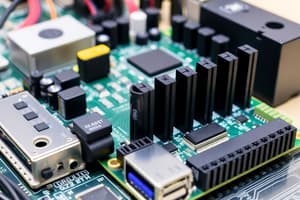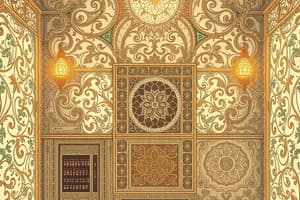Podcast
Questions and Answers
Which of the following is a primary focus of studying computer systems?
Which of the following is a primary focus of studying computer systems?
- Understanding the societal impact of technology.
- Learning to use application software effectively.
- Answering how computers represent data and execute programs. (correct)
- Mastering advanced graphic design techniques.
Which of the following best describes the relationship between hardware and software in a computer system?
Which of the following best describes the relationship between hardware and software in a computer system?
- Software physically supports the hardware components.
- Hardware operates independently of software.
- Software controls the hardware to perform specific tasks. (correct)
- Hardware is a subset of software.
How did the Atanasoff-Berry Computer (ABC) contribute to the evolution of computers?
How did the Atanasoff-Berry Computer (ABC) contribute to the evolution of computers?
- It was the first to use binary digits. (correct)
- It introduced the use of quantum computing principles.
- It was the first mechanical computer.
- It pioneered the use of integrated circuits.
In the context of computer history, what is the significance of the ENIAC?
In the context of computer history, what is the significance of the ENIAC?
What distinguishes the Kenbak-1 from earlier computers?
What distinguishes the Kenbak-1 from earlier computers?
Which of the following best characterizes the Osborne 1's contribution to computing?
Which of the following best characterizes the Osborne 1's contribution to computing?
Which component of a computer is responsible for performing arithmetic and logical operations?
Which component of a computer is responsible for performing arithmetic and logical operations?
What role does the Control Unit play within a computer's central processing unit (CPU)?
What role does the Control Unit play within a computer's central processing unit (CPU)?
How is the frequency of an analog signal defined?
How is the frequency of an analog signal defined?
What is the essential difference between periodic and aperiodic analog signals?
What is the essential difference between periodic and aperiodic analog signals?
Which characteristic of an analog signal is described as the vertical height or magnitude of the wave?
Which characteristic of an analog signal is described as the vertical height or magnitude of the wave?
How is the phase of an analog signal typically measured?
How is the phase of an analog signal typically measured?
What type of information is displayed in the frequency domain representation of a signal?
What type of information is displayed in the frequency domain representation of a signal?
What key property defines digital signals in contrast to analog signals?
What key property defines digital signals in contrast to analog signals?
In the context of digital signals, what does each voltage level typically represent?
In the context of digital signals, what does each voltage level typically represent?
Which statement accurately compares analog and digital signals?
Which statement accurately compares analog and digital signals?
What is the Antikythera mechanism often referred to as?
What is the Antikythera mechanism often referred to as?
What was the main purpose of Pascal's Calculator (Pascaline)?
What was the main purpose of Pascal's Calculator (Pascaline)?
Which of the following describes the main function of the Analytical Engine designed by Charles Babbage?
Which of the following describes the main function of the Analytical Engine designed by Charles Babbage?
Modern computers mostly use digital signals. What is the practical implication of that?
Modern computers mostly use digital signals. What is the practical implication of that?
The unit 'Hertz' (Hz) is used to measure a specific characteristic of analog signals. What does it measure?
The unit 'Hertz' (Hz) is used to measure a specific characteristic of analog signals. What does it measure?
Consider a scenario where you need to transmit audio data wirelessly. Which type of signal could you use?
Consider a scenario where you need to transmit audio data wirelessly. Which type of signal could you use?
In computer architecture, which among these is an example of System Software?
In computer architecture, which among these is an example of System Software?
In the architecture of computers, which of the components accesses the registers?
In the architecture of computers, which of the components accesses the registers?
What does Bit rate = 8 bps represents in a digital signal?
What does Bit rate = 8 bps represents in a digital signal?
What is one key difference between memory units and storage?
What is one key difference between memory units and storage?
Given the grading policies, what percentage of the final grade is determined by assignments and the midterm exam combined?
Given the grading policies, what percentage of the final grade is determined by assignments and the midterm exam combined?
What fundamental aspect of computer systems does Boolean logic directly support?
What fundamental aspect of computer systems does Boolean logic directly support?
An analog signal completes 5 cycles in 1 second. What is its frequency?
An analog signal completes 5 cycles in 1 second. What is its frequency?
If each portion of a digital signals takes 10^{-6} s, what is the frequency?
If each portion of a digital signals takes 10^{-6} s, what is the frequency?
What distinguishes system software from application software within the computer systems hierarchy?
What distinguishes system software from application software within the computer systems hierarchy?
How is frequency calculated given frequency (F) and Time (T)?
How is frequency calculated given frequency (F) and Time (T)?
What concept does 'analogue' refer to in the context of signals, distinguishing it from 'digital'?
What concept does 'analogue' refer to in the context of signals, distinguishing it from 'digital'?
What is the role of Device Drivers in the structure of computer systems?
What is the role of Device Drivers in the structure of computer systems?
How did the Atanasoff-Berry Computer (ABC) improve accuracy of scientific calcululations?
How did the Atanasoff-Berry Computer (ABC) improve accuracy of scientific calcululations?
The text mentions Quantum computers as a 'Current development'. What might be a goal of Quantum computers?
The text mentions Quantum computers as a 'Current development'. What might be a goal of Quantum computers?
If the same sine wave in the frequency domain has a peak value of 5 V, frequency of 6 Hz, what might a Time domain plot look like?
If the same sine wave in the frequency domain has a peak value of 5 V, frequency of 6 Hz, what might a Time domain plot look like?
Which component of a computer contains Registers?
Which component of a computer contains Registers?
Why are digital signals widely favored in modern computers?
Why are digital signals widely favored in modern computers?
Flashcards
What is an abacus?
What is an abacus?
The abacus is an ancient calculating tool capable of performing basic arithmetic operations.
What is the Antikythera Mechanism?
What is the Antikythera Mechanism?
An early mechanical analog computer built in ancient Greece, used to predict astronomical positions and eclipses.
What is Pascaline?
What is Pascaline?
A mechanical calculator invented by Blaise Pascal in the 17th century to help his father with tax collection.
What is the Analytical Engine?
What is the Analytical Engine?
Signup and view all the flashcards
What is the Atanasoff-Berry Computer (ABC)?
What is the Atanasoff-Berry Computer (ABC)?
Signup and view all the flashcards
What is ENIAC?
What is ENIAC?
Signup and view all the flashcards
What is the Kenbak-1?
What is the Kenbak-1?
Signup and view all the flashcards
What is the Osborne 1?
What is the Osborne 1?
Signup and view all the flashcards
What is hardware?
What is hardware?
Signup and view all the flashcards
What is software?
What is software?
Signup and view all the flashcards
What is system software?
What is system software?
Signup and view all the flashcards
What is application software?
What is application software?
Signup and view all the flashcards
What are Computer Systems?
What are Computer Systems?
Signup and view all the flashcards
What is a CPU?
What is a CPU?
Signup and view all the flashcards
What are Registers?
What are Registers?
Signup and view all the flashcards
What is the ALU?
What is the ALU?
Signup and view all the flashcards
What is the Control Unit?
What is the Control Unit?
Signup and view all the flashcards
What is an Input Unit?
What is an Input Unit?
Signup and view all the flashcards
What is an Output Unit?
What is an Output Unit?
Signup and view all the flashcards
What is the Storage Unit?
What is the Storage Unit?
Signup and view all the flashcards
What are Analog signals?
What are Analog signals?
Signup and view all the flashcards
What is a Periodic analog signal?
What is a Periodic analog signal?
Signup and view all the flashcards
What is a Non-Periodic analog signals?
What is a Non-Periodic analog signals?
Signup and view all the flashcards
What is a Cycle?
What is a Cycle?
Signup and view all the flashcards
What is Frequency?
What is Frequency?
Signup and view all the flashcards
What is the Amplitude?
What is the Amplitude?
Signup and view all the flashcards
What is the Phase?
What is the Phase?
Signup and view all the flashcards
What is Frequency-domain Plot?
What is Frequency-domain Plot?
Signup and view all the flashcards
What is Digital?
What is Digital?
Signup and view all the flashcards
Study Notes
- CSIT 230 Computer Systems, School of Computing, Montclair State University, Dr. Prince Waqas Khan
Course Objectives
- Introduce fundamental aspects of computer systems
- Explore computer architecture and organization
- Develop skills in Boolean logic and circuit design
- Study digital design principles
- Learn Assembly language programming
- Apply theoretical concepts to practical computer system design
Further Reading
- "Computer Systems Digital Design, Fundamentals of Computer Architecture and Assembly Language" by Ata Elahi
Grading Policies
- Assignments account for 20% of the grade
- Midterm Exam accounts for 25% of the grade
- Final Exam accounts for 45% of the grade
- Discussion accounts for 10% of the grade
CSIT 230 Overview
- Other policies are detailed in the syllabus
Key Questions to be Answered
- How does a computer represent data?
- What operations does a computer understand?
- How a program executes?
- What happens when a user types on the keyboard?
- How do text and drawings appear on a display?
- How do things work inside this wondrous box?
Computer Systems
- Encompass both hardware and software components
Software Components:
- System Software: Includes Operating Systems and Device Drivers.
- Application Software
- Language Processors: Assemblers, Compilers, and Interpreters.
Historical Highlights in Computing:
- 2700 BCE: Abacus
- 140 B.C.: The Antikythera Mechanism
- 1642: Pascal's Calculator (Pascaline)
- 1822: Analytical Engine (Charles Babbage)
- 1941: Atanasoff-Berry Computer (ABC)
- 1945: Electronic Numerical Integrator and Calculator (ENIAC)
- 1971: First PC
- 1981: First commercial laptop
- 2024: Quantum computers being developed
Abacus
- Abacus is an ancient calculating tool from 2300-2700 B.C. capable of performing the four basic arithmetic operations.
Antikythera Mechanism
- Built in ancient Greece between 150-100 B.C.
- Considered the world's first analog computer
- Designed to align the number of lunar months with years
Pascaline
- Blaise Pascal invented and built the Pascaline to help his father, a tax collector.
Analytical Engine
- Mechanical computer designed to compute mathematical tables, including logarithmic and trigonometric functions
Atanasoff-Berry Computer (ABC)
- The world's first electronic digital computer
- Designed to speed up and improve the accuracy of scientific calculations.
- It was the first to use binary digits
ENIAC
- Electronic Numerical Integrator and Computer
- The world's first general-purpose electronic computer
Kenbak-1
- Released in early 1971, it is considered to be the world's first personal computer.
- Built using small-scale integrated circuits and did not use a microprocessor
Osborne 1
- The first commercially successful portable computer, released in 1981
Basic Components of a Computer
- Memory Unit
- Input Unit
- CPU: Registers, ALU, Control Unit
- Output Unit
- Storage
Analog Signals
- Analogue means something continuous. A set of specific points of data and all possible points between them.
- An analog signal is a signal whose amplitude is a function of time and changes gradually as time changes.
- Analog signals can be classified as nonperiodic (aperiodic) and periodic signals.
Periodic Analog Signals
- Repeats its pattern at regular intervals, like a sine wave with a consistent frequency
Non-Periodic Analog Signal
- Does not repeat its pattern, like a voice signal which constantly changes in amplitude and frequency
Characteristics of an Analog Signal:
- Cycle
- Frequency
- Amplitude
- Phase
Cycle
- A cycle/period in an analog signal refers to one complete repetition of its waveform.
- Can be measured from its zero point to its positive peak, then back down to its negative peak, and finally returning to zero again.
Frequency
- The rate of change with respect to time
- The number of cycles in 1 second
- Represented in Hertz (Hz)
- Equation for frequency is f = 1/T
- T is time
Amplitude
- Refers to the vertical height or magnitude of the wave
- Represents the strength or intensity of the signal at any given point in time
Phase
- Describes the position of the waveform relative to time
- Typically measured in degrees (0-360)
Frequency Domain Representation
- Displays the distribution of a signal's energy across different frequencies.
- The horizontal axis represents frequency
- The vertical axis represents the amplitude of the signal
- Appears as a single peak at the dominant frequency
Digital Signals
- Digital refers to something discrete
- Represent data using discrete values
- Represented by two voltages: one voltage represents the number 0 in binary, and the other voltage represents the number 1 in binary. -Logic Level HIGH is True, On, 1 -Logic Level LOW is False, Off, 0
Key differences between analog and digital signals
- Analog signals feature a continuous waveform that varies smoothly over time
- Digital signals feature discrete values represented as binary (0s and 1s)
- It is more complex to store analog, requires high-quality media, whereas digital is easier
- Examples of analog are radio waves, human voice, vinyl records, while digital is examples are CDs, digital audio files, computer data
- Generally less expensive for simple analog systems
- Analog is more complex to process and manipulate, whereas digital is easier
Key Takeaways
- Course Introduction: Objectives and Policies
- Background: History and basic computer components
- Signals: Understanding analog vs digital signals
- Next Lecture: Number Systems (Decimal, binary, octal, hexadecimal)
Studying That Suits You
Use AI to generate personalized quizzes and flashcards to suit your learning preferences.




